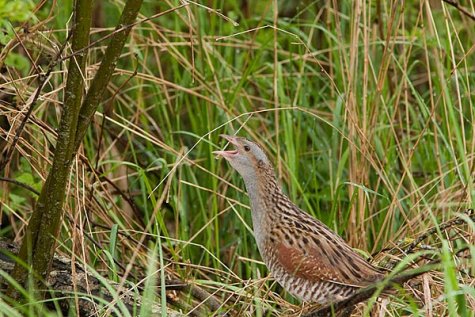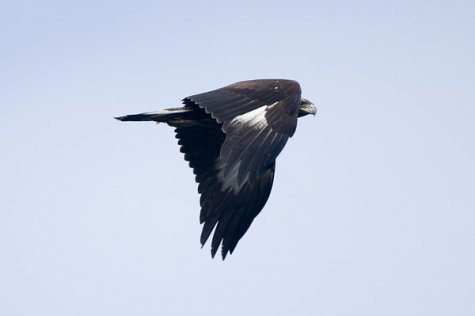Birder’s diary - 25.-26.05
Birder Margus Ots, Linnuvaatleja.ee
Photo: Kaarel Kaisel and Arne Ader
Translation: Liis
Corn crake
The plan was to go on a bird trip on Friday night but to start with I had no good ideas about for how long or where to go at all. So I thought that I might go and have a look at what is happening directly at Tartu in the Aardla polder. This could be a "dangerous“ thought because a few years ago I went likewise to the Aardla polder just for a look in the evening and the next morning found myself on the Saaremaa north-western coast at Harilaiu. Hopefully things will not turn out as crazily this time.
There were plenty of birds in the Aardla polder. It was a warm evening, spotted crakes (Porzana porzana) and corn crakes (Crex crex) were calling nicely, among more interesting species I saw the red-necked phalarope and heard the great snipe (Gallinago media) . But suddenly a reddish-coloured duck was in the telescope sight. The bird was standing on a tussock and grooming itself; the pattern on the wings and underparts was nicely visible. All clear, the creature was the ferruginous duck (Aythya nyroca)or white-eyed pochard found here a few days earlier. Suddenly another but slightly paler bird appeared nearby and ... the birds mated! Was this really a ferruginous duck pair? Does the species really intend to breed here? The info went out at once by Rariliin (Birdline) and before dark some faster birdwatchers managed to twitch it. We looked the birds up once more and could now study the thing closer in the last of the daylight. It was a ferruginous duck pair! This species has been seen in Estonia only 8 times earlier according to information at the Bird rarities committee. A pair however has not been seen here before. Have to be observed, maybe the creatures plan to nest here too for the first time. A photo of the ferruginous duck seen a few days earlier can be seen in the Estbirding gallery.
As we were already out we made a tour of the polder and heard night-time singers in many places. Corn crakes were calling in all directions, spotted crakes were altogether nearly 40, some water rails (Rallus aquaticus) called too. In the last stopping place, actually where the white-eyed pochard was found, a female little crake called too. This species has been heard surprisingly little in Estonia this year (maybe in 4 places?). I have checked the larger part of the earlier finding places during the last weeks and hadn’t yet met it earlier this year. Encouraged by the exciting finds I headed for the southern tip of the Võrtsjärv, to the Valguta polder and Vooremäe, maybe some creature would be calling there. There were many spotted crakes to hear but no one else in particular caught my ear. At the Valguta polder I at last got the nightjar (Caprimulgus europaeus)for my year list, one bird was sitting in the middle of the road.
At Pikasilla I needed to make up my mind whether to go back to Tartu or to proceed to the western coast. A week ago a little bittern (Ixobrychus minutus) had been seen at the Pikla dams in Pärnumaa. Despite active searches it was not found again But the night was calm and relatively warm and birds were calling loudly. Maybe the creature was there after all and I would succeed in hearing it today? So I went straight to Pikla, arriving there at 3:30. It was calm, but cloudy and fine rain was coming down. Nobody much called and as it was still quite dark I decided to sleep for an hour. Precisely at 4:30 I opened the car door and what the h….!!! From the reeds the bellowing croakings of the little bittern were heard. I was wide awake at once and set about to look for the owner of the voice. The bird called nearly 30 times to start with, then fell quiet. I climbed up in the bird tower between the ponds and a moment later the little bittern flew out from the reeds and headed for shelter in the reed strip on the other side of the pond. There the bird continued its steady croaking, only fell quiet for a few short moments. I sneaked closer to the bird and got to maybe 10 m distance but in the dense reeds the bird was not to be found. But I could at least record the voice on my mobile, for the Bird rarities committee there is now evidence of this bird. The little bittern is a real rarity in Estonia, according to data at the Bird rarities committee it has been encountered here only 13 times, most recently in 1992 and before that in 1972. Thus none of the present generation of birders have this species in their lists. The info at once went out by Rariliin . Unfortunately the local Häädemeeste and Võiste birders were in Kihnu. A quick reaction came instead from a Finnish twitcher who was nearby and awake early. With him we tried to find the croaker again in the reeds but ewe did not succeed in seeing it although we only were some 10-15 metres away form the bird. The little bittern called actively for more than an hour altogether and then fell silent. Since the species identification was definite now we can expect larger crowds of twitchers in Pikla during the next nights.
Golden eagle
I myself moved slowly towards the Matsalu bay. On the way I checked several good bird spots. Among the more exciting birds I saw a golden eagle (Aquila chrysaetos), at Audru polder some ten red-necked phalaropes(Phalaropus lobatus) were in place and a large group of whooper swans (Cygnus cygnus) , among them also 2 Bewicks swans (Cygnus columbianus). What were these swans doing here? Why hadn’t they flown to the north? For Bewick’s swans the end of May is an extraordinarily late date. In the evening I reached the Virtsu neighbourhood. The incident of a few years back almost repeated itself, when at the thought that „ have a look what happens at Aardla polder“ I found myself suddenly in Harilaiu. This time I fortunately managed to remain on the mainland. In the last night my year list had 4 interesting species added, in 2012 I have now seen altogether 258 bird species.










